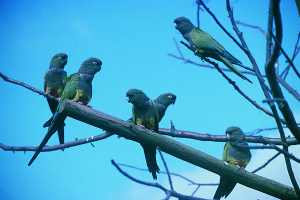Conure - Patagonian
Lesser Patagonian Conure Scientific Name: Cyanoliseus patagonus patagonus
Fri, 30th May, 2025 - 3:03 pm GMT
Sponsor Ads:

Alternative Name
Lesser Patagonian Conure Scientific Name: Cyanoliseus patagonus patagonusBasic Info
Because of their large size and attractive plumage, the Patagonian Conure is often described as striking. Their overall coloring is olive green; there is some yellowish tinge on the side of the wings as well as the head. The breast is grey with some blue highlights; though on the Patagonian Conure there can sometimes be white on the sides of the upper breast. There is some red on the abdomen and inner thigh as well as some yellow. The primary flight feathers are dark blue. The tail feathers are olive green on the upper side and edged in blue. The undersides are dark grey. The Patagonian Conure has white eyes when mature, while the young have brown irises. The eye is ringed with a bare white area. An interesting note is that the Patagonian Conure is the only member of the Conure species that has feathers covering their nostrils. The beak is black on the adult and the upper beak is white on the young. The feet of the Patagonian Conure are flesh colored. They reach a length of 18 inches (45 centimeters) and the adults achieve their true coloring at one year of age. Some describe the Patagonian Conure as resembling some of the Mini Macaws.
Health
When feeding the Patagonian Conure, it is always best to offer either a pellet diet or at least a fortified seed diet. As with most parrots, always offer them fresh fruits and vegetables, as well as foods such as beans and cooked eggs. Fresh water daily is necessary, as is removing fresh food quickly so it does not spoil. The Lesser Patagonian Conure only needs a vitamin supplement if on a strictly seed diet. The size of the cage should be sufficient to accommodate their wings and room to play. Usually, a 24" by 24" by 36" cage will do, but bigger works well, too. A variety of perches is good exercise for the Lesser Patagonian 's feet, and make sure the food dishes are not directly below a perch, so the food and water is not soiled. Toys are necessary, since Conures are avid chewers. Like other Conures they enjoy bathing and should be given a bath and/or misted regularly. Conures are prone to a vitamin K deficiency and a bleeding disorder, but with the proper nutrition, those can be avoided. Conures are also good flyers, and require more clipping, but never too much, so the bird will fly gently to the floor. The Patagonian Conure may be prone to Pacheco's virus and should be vaccinated against it. Breeding The breeding season for the Patagonian Conure begins in December but sometimes as late as March. Their nest box should be vertical and 14x14x24 inches. They usually have three eggs in a clutch, with incubation lasting 24-25 days. The babies will fledge in about eight weeks. The males do take part in their care and have been seen feeding the chicks in the nest.Habitat
They can be found in bushes, trees, and making nests in the sides of cliffs.Behavior
The Patagonian Conure is the largest of all Conures. They learn to talk and bond well with people, especially if hand raised. The Patagonian Conure, also known as the Lesser Patagonian Conure is the most common of the three subspecies of Patagonian Conure. These Conures are very active. They love to play and climb and chew on toys, making for an entertaining parrot. Their ability to talk is quite good, though they can be very noisy. This fact needs to be considered carefully before taking a Patagonian Conure into your home. These parrots are generally not suitable for apartment living because of their noise potential. Patagonian Conures are usually very sweet parrots. Well-socialized Patagonian Conures will form close bonds with their owners and are affectionate by nature. In the wild, these birds like to make their nests in the sides of cliffs, earning them the nickname "Cliff Dwelling Parrots". The Lesser Patagonian Conure has been known to live as long as 25 years, but the average is 12.Origin
Southern South AmericaHistory
The Patagonian Conures originate in Chile, Argentina and possibly Uruguay. Though their flock numbers were large at one time, they are mostly spotted in smaller groups during feeding time. Today the Patagonian Conure is considered endangered in the wild, and that is due in part to immature individuals being sought as a culinary delicacy. The adults were frequently shot and the babies were taken from their nests and eaten. Additionally development of their natural habitats and farmers routinely kill them as pest control have contributed to their decline in the wild. They now have protection in Chile with new laws.Common Foods
N/ASponsor Ads:
Any preoccupation with ideas of what is right and wrong in conduct shows and arrested intellectual development. --Oscar Wilde
Conure - Patagonian
Coded by: BGID® | ALL RIGHTS RESERVED Copyright © 2000-2025
Disclaimer | Privacy | Report Errors / Contact | Credits

 President of the United States of America - Real Estate mogul, Pageant owner and now one of the most controversial men in political history.
President of the United States of America - Real Estate mogul, Pageant owner and now one of the most controversial men in political history.  Politician, US Vice President and President of the USA - Joseph Robinette Biden Jr.
Politician, US Vice President and President of the USA - Joseph Robinette Biden Jr.  versus
versus  Russia: 'The Evil Empire'? Are they all that bad or is it just the USA trying to portray Russia as bad because they are a world power with land bigger and a society very different from the USA ideal?
Russia: 'The Evil Empire'? Are they all that bad or is it just the USA trying to portray Russia as bad because they are a world power with land bigger and a society very different from the USA ideal?  Global warming has been in and out as the "latest" hot topic for many years. It is, according to modern scientists, the result of man-made industrial pollutants, clearing forested areas, agriculture, etc. But now they are thinking it started way before the Industrial Revolution...
Global warming has been in and out as the "latest" hot topic for many years. It is, according to modern scientists, the result of man-made industrial pollutants, clearing forested areas, agriculture, etc. But now they are thinking it started way before the Industrial Revolution... 
 Corona virus
Corona virus 
 Users with wide screen monitors can benefit from more content on every page.
Users with wide screen monitors can benefit from more content on every page.